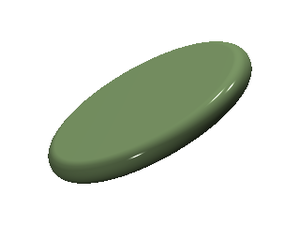Oblate hard spherocylinders

The oblate hard spherocylinder model [1], also known as a discotic spherocylinder, consists of an impenetrable cylinder, surrounded by a torus. In the limit of zero diameter the oblate hard spherocylinder becomes a hard sphere, and in the limit of zero width one has the hard disk. A closely related model is that of the hard spherocylinder.
Overlap algorithm
An overlap algorithm is provided in the appendix of [2].
Excluded volume
Virial coefficients
Columnar phase
Oblate hard spherocylinders form a columnar phase [5]
See also
References
- ↑ M. Wojcik and K. E. Gubbins "Thermodynamics and structure of hard oblate spherocylinder fluids", Molecular Physics 53 pp. 397-420 (1984)
- ↑ Matthieu Marechal, Alejandro Cuetos, Bruno Martínez-Haya, and Marjolein Dijkstra " Phase behavior of hard colloidal platelets using free energy calculations", Journal of Chemical Physics 134 094501 (2011)
- ↑ Bela M. Mulder "The excluded volume of hard sphero-zonotopes", Molecular Physics 103 pp. 1411-1424 (2005)
- ↑ W. R. Cooney, S. M. Thompson and K. E. Gubbins "Virial coefficients for the hard oblate spherocylinder fluid", Molecular Physics 66 pp. 1269-1272 (1989)
- ↑ Alejandro Cuetos and Bruno Martínez-Haya "Columnar phases of discotic spherocylinders", Journal of Chemical Physics 129 214706 (2008)
- Related reading
- J. Šedlbauer, S. Labík, and A. Malijevský "Monte Carlo and integral-equation studies of hard-oblate-spherocylinder fluids", Physical Preview E 49 pp. 3179-3183 (1994)
- Bruno Martiacutenez-Haya and Alejandro Cuetos "Simulation study of discotic molecules in the vicinity of the isotropic-liquid crystal transition", Molecular Simulation 35 pp. 1077-1083 (2009)